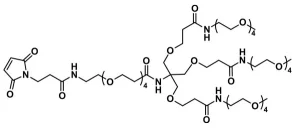Bis-MAL-Lysine-dPEG®4-dPEG®12-Tris(-dPEG®24 acid)3, product number QBD-11630, is a unique product from Vector Laboratories. It consists of a carboxylic-acid terminated, branched dPEG® construct built around a tris core and functionalized with a short dPEG® linker that contains two thiol-reactive maleimide groups attached to lysine. The dPEG® spacers are 152 and 156 atoms, with average lengths of 113.0 and 115.4 Å. The tris-core branched portion of this product is designed to modify the pharmacodynamics (PD), pharmacokinetics (PK), and biodistribution (BD) of conjugated biomolecules, while the bis-maleimide moiety is designed to bridge disulfide bonds by forming stable thioether bonds through the thiol-maleimide reaction.
This product is designed for modifying biomolecules like antibodies and antibody fragments but can be used in any bioconjugate application where free thiols are available for reaction. The two maleimide groups can bridge a reduced disulfide bond through the thiol-maleimide reaction, forming stable thioether bonds. Potential product applications include reducing or eradicating renal clearance, extending in vivo circulating half-life, and suppressing immune responses to conjugates. Users should note that the free carboxylates on the three long arms of the molecule may alter the charge of conjugates formed with Bis-MAL-Lysine-dPEG®4-dPEG®12-Tris(-dPEG®24 acid)3.
Vector Laboratories’ dPEG® technology provides high-quality, single molecular weight, discrete chain-length PEG (dPEG®) products for bioconjugation in therapeutic, diagnostic, and clinical research applications. Unlike traditional, non-uniform polymer PEGs, dPEG® products are synthesized in stepwise fashion from high-purity starting materials. The amphiphilic dPEG® construct imparts hydrophilicity to conjugates, reduces or eliminates the conjugates’ antigenicity, and increases the hydrodynamic volume of conjugated molecules. With increased hydrodynamic volume, the renal clearance of conjugate molecules is reduced or eliminated. Moreover, optimization of the conjugate molecule’s BD, PK, and PD is possible.
| Unit Size | 25 mg, 100 mg |
|---|---|
| Molecular Weight | 4999.80; single compound; |
| Chemical formula | C₂₂₄H₄₂₂N₁₀O₁₀₉ |
| CAS | N/A |
| Purity | > 95% |
| Spacers | dPEG® Spacers are 152 and 156 atoms; 113 and 115.4 Å, avg. |
| Shipping | Ambient |
| Typical solubility properties (for additional information contact Customer Support) | Methylene Chloride, DMSO or Acetonitrile. |
| Storage and handling | -20°C; Always let come to room temperature before opening; be careful to limit exposure to moisture and restore under an inert atmosphere; stock solutions can be prepared with dry solvent and kept for several days (freeze when not in use). dPEG® pegylation compounds are generally hygroscopic and should be treated as such. This will be less noticeable with liquids, but the solids will become tacky and difficult to manipulate, if care is not taken to minimize air exposure. |
Greg T. Hermanson, Bioconjugate Techniques, 3rd Edition, Elsevier, Waltham, MA 02451, 2013, ISBN 978-0-12-382239-0; See Chapter 18, Discrete PEG Reagents, pp. 787-821, for a full overview of the dPEG® products.
Applicable patents and legal notices are available at legal notices.




Stay in the Loop. Join Our Online Community
Products
Ordering
About Us
Application
Resources

©Vector Laboratories, Inc. 2025 All Rights Reserved.
To provide the best experiences, we use technologies like cookies to store and/or access device information. Consenting to these technologies will allow us to process data such as browsing behavior or unique IDs on this site. Not consenting or withdrawing consent, may adversely affect certain features and functions. Privacy Statement
How do I Request a Quote?
To request a quote for products: